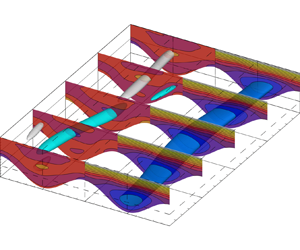Article contents
Slowing down convective instabilities in corrugated Couette–Poiseuille flow
Published online by Cambridge University Press: 13 October 2022
Abstract

Couette–Poiseuille (CP) flow in the presence of longitudinal grooves is studied by means of numerical analysis. The flow is actuated by movement of the flat wall and pressure imposed in the opposite direction. The stationary wall features longitudinal grooves that modify the flow, change hydrodynamic drag on the driving wall and cause onset of hydrodynamic instability in the form of travelling waves with a consequent supercritical bifurcation, already at moderate ranges of the Reynolds number. We show that by manipulating this system it is possible to significantly decrease phase speed of the unstable wave and to effectively decouple time scales of wave propagation and amplification with a potential to significantly reduce the distance required for the onset of nonlinear effects. Current analysis begins with concise characterization of stationary, laminar CP flow and the effects of applying a selected corrugation pattern, followed by determination of conditions leading to the onset of instabilities. In the second part we illustrate selected nonlinear solutions obtained for low, supercritical values of the Reynolds numbers and due to the amplification of unstable travelling waves of possibly low phase velocities. This work is concluded with a short discussion of a linear evolution of a wave packet consisting of a superposition of a number of unstable waves and initiated by a localized pulse. This part illustrates that in addition to the reduction of the phase velocity of a single, unstable mode, imposition of the Couette component also reduces group velocity of a wave packet.
JFM classification
Information
- Type
- JFM Papers
- Information
- Copyright
- © The Author(s), 2022. Published by Cambridge University Press
References
REFERENCES
- 3
- Cited by


